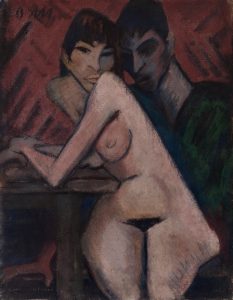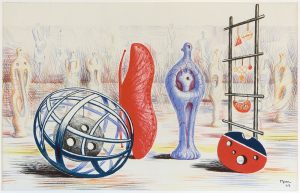Painting and prints
Integrated into the presentation of international sculpture is the select collection of German painting ranging from the turn of the 20th century to the 1960s. The Duisburg museum also boasts an impressive collection of prints.
Painting in the Lehmbruck Museum – from Expressionism to Abstract Art
The paintings that currently make up Lehmbruck Museum’s collection were for the most part acquired between 1954 and 1970 by the director at the time Gerhard Händler. Its masterpieces include works by members of the “Die Brücke” group of artists such as Ernst-Ludwig Kirchner, Erich Heckel, Karl Schmidt-Rottluff, Max Pechstein and Otto Mueller as well as by Emil Nolde, who had close associations with them, and works by artists such as August Macke, Heinrich Campendonk and Christian Rohlfs from the Rhineland-Westphalia region. Paintings by Alexej von Jawlensky, Oskar Kokoschka and the “Sturm” magazine artists Johannes Molzahn and Thomas Ring complement the Expressionist paintings by the “Brücke” artists.

Otto Mueller, Paar in der Kaschemme, um 1921/22, Photo: Dejan Saric
The works that make up the next large group, which initially derived its productive thrust from Cubism, are linked by constructive trends. Among others Oskar Schlemmer, Walter Dexel, Lyonel Feininger and Georg Muche represent Bauhaus; Max Beckmann’s “Rugby Players” and Max Ernst’s “The Temptation of St. Anthony” are regarded as outstanding examples of Expressionism, New Objectivity, and Surrealism.
Following the end of the Second World War, Abstract Art emerged as an international artistic phenomenon. Many German artists saw abstract painting as a liberation from and the only valid alternative to realistic art, which had been used as an instrument and perverted by fascist ideologies and had acquired a new dogma through Socialist Realism. Even today the powerful, often archaic desire for expression and the sense of liberation after dictatorship and war can be felt in the works by Willi Baumeister, Ernst Wilhelm Nay, Emil Schumacher, Karl Otto Götz, Gerhard Hoehme and Bernhard Schultze. The struggle for new forms and new functions for art reveals itself to be a process of creating pictures from gestures or material, which towards the late 1950s imbued art with a new objective character. The borderline between painting and objects and sculpture began to become blurred.

Henry Moore, Skulpturale Objekte, 1949 © Henry Moore Foundation, Foto: Museum
Prints and drawings from the works of important sculptors
Lehmbruck Museum’s Prints Collection boasts in excess of 8,800 works on paper, 2,400 drawings, 5,060 prints, and 1,350 photographs. What makes this collection unique is its focus on drawings and prints by 20th century sculptors of international significance. Historically, the Prints Collection was built up parallel to the purchases made by the sculpture and painting collection as of late 1924. Roughly speaking, until 1957 the entire collecting program concentrated on 20th century German art, before in 1958 – coinciding with the decision to construct the Lehmbruck Museum – opening up to international Modern art.
Please note that not all of the collection’s pieces can be displayed.
For relevant information please call:
T: +49 (0)203 283-3294